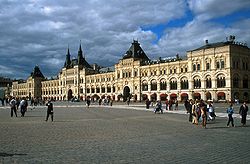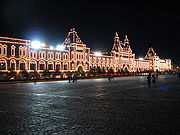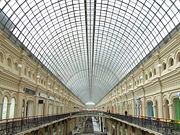
State Universal Store
Encyclopedia

Department store
A department store is a retail establishment which satisfies a wide range of the consumer's personal and residential durable goods product needs; and at the same time offering the consumer a choice of multiple merchandise lines, at variable price points, in all product categories...
in many cities of the former Soviet Union
Soviet Union
The Soviet Union , officially the Union of Soviet Socialist Republics , was a constitutionally socialist state that existed in Eurasia between 1922 and 1991....
, known as State Department Store during the Soviet times. Similar-named stores were in some Soviet republics and post-Soviet states. The most famous GUM is a large store in the Kitai-gorod
Kitai-gorod
Kitay-gorod , earlier also known as Great Posad , is a business district within Moscow, Russia, encircled by mostly-reconstructed medieval walls. It is separated from the Moscow Kremlin by Red Square. It does not constitute a district , as there are no resident voters, thus, municipal elections...
part of Moscow
Moscow
Moscow is the capital, the most populous city, and the most populous federal subject of Russia. The city is a major political, economic, cultural, scientific, religious, financial, educational, and transportation centre of Russia and the continent...
, facing Red Square
Red Square
Red Square is a city square in Moscow, Russia. The square separates the Kremlin, the former royal citadel and currently the official residence of the President of Russia, from a historic merchant quarter known as Kitai-gorod...
. It is actually a shopping mall. Prior to the 1920s the place was known as the Upper Trading Rows .
Moscow GUM
With the façade extending for 794 ft (242 m) along the eastern side of Red Square, the Upper Trading Rows were built between 1890 and 1893 by Alexander PomerantsevAlexander Pomerantsev
Alexander Nikanorovich Pomerantsev was a Russian architect and educator responsible for some of the most ambitious architectural projects realized in Imperial Russia and Bulgaria at the turn of the 20th century...
(responsible for architecture) and Vladimir Shukhov
Vladimir Shukhov
Vladimir Grigoryevich Shukhov , was a Russian engineer-polymath, scientist and architect renowned for his pioneering works on new methods of analysis for structural engineering that led to breakthroughs in industrial design of world's first hyperboloid structures, lattice shell structures, tensile...
(responsible for engineering). The trapezoidal building features an interesting combination of elements of Russian medieval architecture
Russian Revival
The Russian Revival style is the generic term for a number of different movements within Russian architecture that arose in second quarter of the 19th century and was an eclectic melding of pre-Peterine Russian architecture and elements of Byzantine architecture.The Russian Revival style arose...
and a steel
Steel
Steel is an alloy that consists mostly of iron and has a carbon content between 0.2% and 2.1% by weight, depending on the grade. Carbon is the most common alloying material for iron, but various other alloying elements are used, such as manganese, chromium, vanadium, and tungsten...
framework and glass
Glass
Glass is an amorphous solid material. Glasses are typically brittle and optically transparent.The most familiar type of glass, used for centuries in windows and drinking vessels, is soda-lime glass, composed of about 75% silica plus Na2O, CaO, and several minor additives...
roof, a similar style to the great 19th century train station
Train station
A train station, also called a railroad station or railway station and often shortened to just station,"Station" is commonly understood to mean "train station" unless otherwise qualified. This is evident from dictionary entries e.g...
s of London
London
London is the capital city of :England and the :United Kingdom, the largest metropolitan area in the United Kingdom, and the largest urban zone in the European Union by most measures. Located on the River Thames, London has been a major settlement for two millennia, its history going back to its...
. Nearby, also facing Red Square, is a very similar building, known formerly as the Middle Trading Rows.

William Craft Brumfield
William Craft Brumfield is a contemporary American historian of Russian architecture, a preservationist and an architectural photographer. Brumfield is currently Professor of Slavic studies at Tulane University....
as "a tribute both to Shukhov's design and to the technical proficiency of Russian architecture
Russian architecture
Russian architecture follows a tradition whose roots were established in the Eastern Slavic state of Kievan Rus'. After the fall of Kiev, Russian architectural history continued in the principalities of Vladimir-Suzdal, Novgorod, the succeeding states of the Tsardom of Russia, the Russian Empire,...
toward the end of the 19th century" — was built to replace the previous trading rows that had burnt down during 1825. The glass-roofed design made the building unique at the time of construction. The roof, the diameter of which is 46 ft (14 m), looks light, but it is a firm construction made of more than 50,000 metal pods (about 819 ST (731.2 LT), capable of supporting snowfall accumulation. Illumination is provided by huge arched skylights of iron and glass, each weighing some 820 ST (732.1 LT) and containing in excess of 20,000 panes of glass. The facade is divided into several horizontal tiers, lined with red Finnish granite, Tarusa
Tarusa
Tarusa is a town and the administrative center of Tarussky District of Kaluga Oblast, Russia, located on the left bank of the Oka River, south of Serpukhov, northeast of Kaluga, and about south of Moscow. Population:...
marble, and limestone. Each arcade is on three levels, linked by walkways of reinforced concrete.
By the time of the Russian Revolution of 1917
Russian Revolution of 1917
The Russian Revolution is the collective term for a series of revolutions in Russia in 1917, which destroyed the Tsarist autocracy and led to the creation of the Soviet Union. The Tsar was deposed and replaced by a provisional government in the first revolution of February 1917...
, the building contained some 1,200 stores. After the Revolution, the GUM was nationalised and continued to be used as a department store until Joseph Stalin
Joseph Stalin
Joseph Vissarionovich Stalin was the Premier of the Soviet Union from 6 May 1941 to 5 March 1953. He was among the Bolshevik revolutionaries who brought about the October Revolution and had held the position of first General Secretary of the Communist Party of the Soviet Union's Central Committee...
converted it into office space in 1928 for the committee in charge of his first Five Year Plan. After the suicide
Suicide
Suicide is the act of intentionally causing one's own death. Suicide is often committed out of despair or attributed to some underlying mental disorder, such as depression, bipolar disorder, schizophrenia, alcoholism, or drug abuse...
of Stalin's wife Nadezhda during 1932, the GUM was used briefly to display her body.

Consumer
Consumer is a broad label for any individuals or households that use goods generated within the economy. The concept of a consumer occurs in different contexts, so that the usage and significance of the term may vary.-Economics and marketing:...
goods, and the queue
Queue
A queue is a particular kind of collection in which the entities in the collection are kept in order and the principal operations on the collection are the addition of entities to the rear terminal position and removal of entities from the front terminal position. This makes the queue a...
s of shoppers were long, often extending entirely across Red Square.
At the end of the Soviet era, GUM was partially then fully privatized, and it had a number of owners before it ended owned by the supermarket company Perekryostok. During May 2005, a 50.25% interest was sold to Bosco di Ciliegi, a Russian luxury-goods distributor and boutique operator. As a private shopping mall, it was renamed in such a fashion that it could maintain its old abbreviation and thus still be called GUM. However, the first word Gosudarstvennyj ('state') has been replaced with Glavnyj ('main'), so that GUM is now an abbreviation for "Main Universal Store".
It is still open nowadays, and is a popular tourist
Tourism
Tourism is travel for recreational, leisure or business purposes. The World Tourism Organization defines tourists as people "traveling to and staying in places outside their usual environment for not more than one consecutive year for leisure, business and other purposes".Tourism has become a...
destination for those visiting Moscow. Many of the stores feature fashionable brand names familiar in the West; locals refer to these as the "exhibitions of prices", the joke being that no one could afford actually to buy any of the items displayed. As of 2005, there were approximately 200 stores.
There is a similar historic department store that rivals GUM in size, elegance and opulent architecture named Central Universal Store
Muir & Mirrielees
TsUM – Central Universal Department Store – is one of the most renowned department stores in Moscow. It is located in a six-story historical building at Petrovka street. TSUM is a part of Mercury group.- TSUM today :...
(Tsentralniy Universalniy Magazin, abbreviated as TsUM). It sprawls just east of the Bolshoi Theatre
Bolshoi Theatre
The Bolshoi Theatre is a historic theatre in Moscow, Russia, designed by architect Joseph Bové, which holds performances of ballet and opera. The Bolshoi Ballet and Bolshoi Opera are amongst the oldest and most renowned ballet and opera companies in the world...
.
External links


